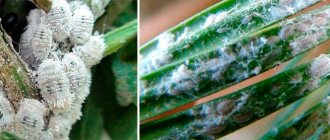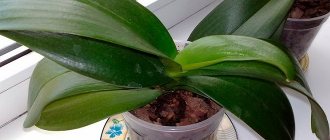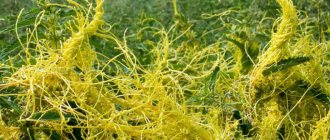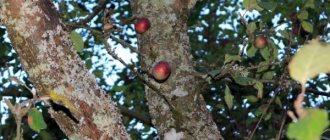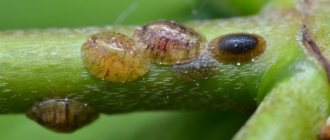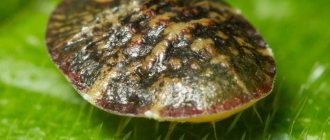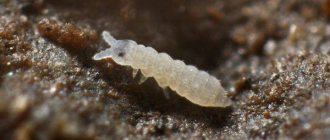Spider mite
Spider mites are one of the most common pests found on houseplants. Often they come indoors along with bouquets or potted flowers purchased at the store. Insects settle on the underside of leaves and on shoots, mainly young ones, eventually entangling them with cobwebs. If there are a large number of pests, the secretion of the arachnoid glands secreted by them, which turns into the thinnest threads in the air, can entwine the entire plant, which leads to discoloration, drying and falling of the leaves. Flowers, ovaries and fruits are also damaged.
The spread of mites is facilitated by dry air in the apartment and the presence of dust on the plant, so it is very useful for the tree to give it a weekly warm shower. Particular care should be taken to wash the undersides and axils of the leaves and the growing points of the shoots. To prevent the soil from being washed away, and along with it the nutrients, the soil must be covered with plastic film, cardboard, or thick paper during the procedure. Every day, it is advisable to spray the plant with settled water at room temperature (or a little warmer). For prevention, every month it is recommended to wipe the lemon foliage with a solution of green soap (20-30 g per 1 liter of water), using soft materials, such as cotton wool or napkins.
When ticks are detected, the fight against them begins immediately, using chemical or natural preparations, depending on the degree of damage. Before treating with any means, the plant must be washed thoroughly. With a small number of insects, you can use rosemary-based essential oil (5-6 drops per 1 liter of warm water). The biological product Fitoverm is safe for home use and retains its properties for a week. To destroy mites, spraying the plant must be carried out repeatedly (3-4 times) every seven days.
If the insects were not noticed in time, and they affected most of the tree, you will have to fight with stronger means, which include Actellik, an insectoacaricide with enteric contact action. Dilute the drug in water - 1 ml per 1 liter of water, and treat the lemon with it at least 3 times, maintaining an interval of 7-10 days. It should be noted that Actellik is highly toxic, so you need to work with it outdoors or in a well-ventilated area.
Fungal and infectious
Damage to lemons by fungus or infection at home is not uncommon. The reasons are the same as for infection with viral diseases.
Gomoz
The presence of elongated brown spots on the branches and trunk are the first signs of homosis. The bark under such spots quickly dies and begins to crack. A golden-colored sticky substance forms at the crack sites, which quickly hardens.
The main reasons for the development of homemade lemon disease are mechanical damage to the bark (fractures, cracks), increased humidity in the room, lack of phosphorus-potassium fertilizers in the soil, excess nitrogen, planting in already contaminated soil or deepening the trunk too deep.
A sick specimen should be treated in the following way: remove the infected bark on the trunk, cut off severely affected shoots. Treat the areas of stripping and pruning with any fungicide of 3% concentration and cover with garden varnish.
The duration of treatment will depend on the degree of damage to the tree. The treatment is carried out until brown spots stop forming.
Anthracnose
Of all the diseases, indoor lemons are most often affected by anthracnose. It is determined that this sore appears on the lemon by the leaves: they fall off en masse. But first the leaf blade turns white or yellow. Flower buds also fall. The fruits are covered with reddish spots.
Control measures include removing dead branches and infected leaves. Treat the affected specimen three times with Fitosporin. Another option is to treat the wood with a 1% solution of Bordeaux mixture.
Scab
Scab is another dangerous disease of indoor lemons. Young foliage becomes covered with yellow spots, which after some time turn into pink-gray growths. Leaves on which such plaque appears die. The fungus continues to parasitize, spreading to leaf petioles and nearby shoots. The appearance of this sore is also indicated by orange spots on the skin of the fruit. After some time they darken and become dark red. At an advanced stage, blackening is noticeable in the affected areas.
Treatment of the tree begins by spraying with 1% Bordeaux mixture. All affected parts on the crown are first removed.
Melseko
All affected trees must be destroyed
When infected with Melseco, the tree branches begin to dry out at the tips, and the leaves fall off en masse. When cut, the branches acquire a reddish tint.
The reason is improper care, or rather, lack of light in winter. There is no point in fighting this disease, because all methods are useless. The only thing required is regular inspection of the tree for symptoms.
Affected specimens must be destroyed.
Root rot
It is not uncommon for indoor lemons to lose their leaves. If 1-2 leaves fall off, there is no need to worry: this is a natural process. If there is massive leaf fall, it is worth digging up the tree and inspecting its root system.
If the roots become dark, moldy and soft to the touch, the tree is affected by root rot. All rotten parts are cut off with a sterile knife or pruning shears. The cut areas are powdered with crushed charcoal. Next, transplant into a new flowerpot.
The transplanted lemongrass is placed in a well-lit place with protection from the scorching sun. Watering is allowed only a week after transplantation to prevent repeated rotting of the root system.
Mealybug
The fact that a lemon is affected by a mealybug is indicated by the appearance of a fluffy white coating and sticky transparent insect secretions on the leaves of the plant. Pests suck sap from young branches, buds, leaves and even roots. The lemon stops growing, its leaves dry out, the fruits become covered with spots, cracks and fall off before reaching ripeness. To avoid damage by mealybugs, plants need to be regularly inspected, sprayed, and given a warm shower every week. If insects do appear, water helps wash away most of them. Affected branches and leaves should be removed.
When there are few pests, control methods such as treating the plant with a solution of laundry soap (50 g) and tobacco (20 g per 0.5 l of water) or garlic infusion (several cloves per 0.5 l of water) are suitable. If there are a larger number of scale insects, you can use a soap-tobacco solution with the addition of alcohol for spraying (per 1 liter of water - 50 g of soap, 20 g of tobacco and 40-50 g of alcohol). The biological product Fitoverm has proven itself well, which is also used for preventive purposes.
Severely affected plants are saved with the help of “chemistry”, using Karbofos, Intavir, Decis, Actellik, etc. They must be used strictly according to the instructions, since almost all of them are highly toxic. As a rule, treatment with these drugs is carried out 2-4 times every 10-14 days.
Diseases of indoor lemons and their treatment
The most common lemon diseases can be classified into one of the following groups: fungal, infectious or viral infections. There are quite a lot of them. Based on the symptoms of the disease, a diagnosis is made and the treatment process begins. It is also known that good conditions for maintaining a plant increase its resistance to disease and facilitates the implementation of therapeutic measures.
Gommoz
The causes of gommosis or gum formation can be different. The plant produces gum, which hardens on the trunk and branches in the form of sticky drops. This is a protective reaction to tissue damage.
Damage to the tree may be as follows:
- Fungal infection;
- Bacterial or viral diseases of the lemon tree;
- Mechanical damage to the trunk and branches.
Any mechanical damage can very quickly turn into foci of infection due to fungi and bacteria entering the plant tissue through wounds.
It is very difficult to fight gum disease. The only way is to remove the damaged areas and treat the sections with a solution of copper sulfate. As a result of such disinfection, the cuts become overgrown and the gum ceases to be released.
Gommoz
Sooty fungus
Sooty fungus appears on the surface of the leaves and shoots of a plant affected by pests. Many harmful insects secrete sticky, sweet substances that remain on the leaves. Black mold or sooty fungus develops on these secretions.
Black mold does not feed on lemon tissue. However, by covering the leaves, it interferes with photosynthesis and spoils the appearance of the plant.
A lemon tree covered with sooty fungus slows down its growth and cannot fully develop. Dealing with the disease is simple - black mold must be removed using wipes moistened with warm water. But the main thing is to remove the cause of its occurrence - pests. The tree must be treated with an insecticide to kill harmful insects.
Sooty fungus
Scab and other leaf diseases
Scab is a fungal disease of citrus trees. A symptom of this lemon disease is the appearance of raised spots on the leaves and shoots. Over time, there are more of them, they turn into holes on the leaves, and spots on the shoots crack. Such spots also appear on lemon fruits. Severe damage can cause the ovary to fall off.
The fight against scab is very labor-intensive. As with other fungal infections, the affected leaves and shoots are cut off and destroyed. The above-ground part of the plant is treated with antifungal drugs at intervals of 7-10 days. The most effective are Bordeaux mixture, copper sulfate, and Strobilin.
There are other lemon diseases that affect the leaves of the plant. The most common:
- Powdery mildew is a fungal disease that causes the formation of spots of white powdery coating on the leaves of indoor lemon;
- Leaf mosaic is a viral leaf disease that causes a pattern of light spots and streaks to appear on lemon leaves.
Powdery mildew
Sheet mosaic
Root rot
Root rot is a common fungal disease that affects the root system of a plant and very quickly leads to its death. The reason for the development of this lemon disease is waterlogging of the soil and stagnation of water in it.
At the early stage of the disease, the tree’s growth slows down and its leaves begin to fall off en masse. In this case, the tree can be saved if it is replanted in new soil and sprayed with fungicide at the root.
If a tree has been sick for a long time and the entire root system is no longer functioning, the plant cannot be saved. The lemon begins to lose leaves en masse, its shoots die, and the tree quickly disappears. If there are still branches on the lemon tree untouched by the disease, you can cut cuttings from them for rooting.
Root rot
Wartiness
Wart is a fungal disease that resembles scab. Bumps appear on the leaves of the tree. But over time they turn into gray warts. There can be a lot of them. Warts can almost completely cover leaves and fruits.
Wartiness causes the loss of tree leaves and the falling of ovaries.
It can lead to a serious lemon disease and will end in its death if no measures are taken to save the plant. The fight against warts involves removing all diseased fragments of the lemon crown. Cut leaves and branches are burned to prevent lemon disease from spreading. The lemon tree is treated with fungicidal preparations, the same as for scab disease.
Wartiness
Malsecco
Malsecco is a very dangerous fungal disease that affects young citrus trees. Lemons are especially susceptible to it. This disease manifests itself as drying of shoots and branches. The lesion begins from the top of the crown, gradually spreading downwards.
Diseased specimens are noticeable by their light leaves with darker veins. Yellow or orange rings are visible on the cut of affected branches. The fungus penetrates plant tissue through external damage.
Therefore, for preventive purposes, it is recommended to treat lemons with Bordeaux mixture in early spring.
During the season, the treatment is repeated several times. Trees killed by malsecco are burned to prevent the spread of infection. You can try to save partially affected lemons by removing and destroying the affected areas of the crown.
Malsecco
Citrus cancer
Citrus canker is a bacterial infection that leads to the death of the plant. The first symptoms of this lemon disease are the appearance of small brown spots on the leaves, shoots and fruits.
As the disease progresses, tree growth slows down. Its shoots become twisted and disfigured, and swellings appear on them. The branches and trunk of the plant are covered with cracks and growths. Fruits and ovaries fall from a diseased plant.
Treatment for this lemon disease has not been developed.
The diseased plant dies, so it is recommended to destroy it so that it does not become a source of infection for healthy specimens. It should be remembered that although cancer develops very slowly, large amounts of nitrogen fertilizers contribute to the development of the disease in just a few weeks.
Citrus cancer
Tristeza
Tristeza is a viral infection that is transmitted from a diseased tree to a healthy one. Symptoms include the appearance of necrotic areas on the leaves, shoots and trunk of the tree. On the affected plant, sections of the bark gradually die off, the leaves become covered with yellow spots, in the middle of which the leaf tissue dies.
As the disease progresses, the leaves of the plant become covered with light veins, and the growth of the tree slows down and stops completely. The virus leads to the death of the plant. No treatment has been developed. The diseased plant is destroyed so that it does not become a source of infection .
It should also be remembered that some varieties of lemons are carriers of infection, but do not themselves get sick. Therefore, cuttings taken from outside can become a source of infection of healthy plants.
Tristeza
Anthracnose
Anthracnose is a fungal disease, the symptoms of which are brown spots on the surface of the leaves. The development of the disease is facilitated by prolonged high soil and air humidity at elevated temperatures. The disease progresses rapidly with a lack of potassium and phosphorus in the soil.
In advanced cases, the leaves of the plant completely die and fall off, then the shoots begin to die. As a result, the plant dies if no measures are taken to treat the disease.
With minor lesions, the lemon can be saved. All affected areas of the plant should be removed. Then the above-ground part is treated with an antifungal drug. Fitosporin gives good results. The treatment is repeated every 7-10 days at least 3 times.
Anthracnose
Aphid
Aphids may appear on the lemon, feeding on the sap of the plant. Due to its green color, it is quite difficult to notice. Signs of damage are deformed, sticky leaves and shoot tips. Aphid larvae appear first on the underside of leaf blades; they can also be found on the ovaries. The insect reproduces very quickly; adult individuals are capable of laying a huge number of eggs in a short time. Therefore, when aphids are detected, the necessary measures must be taken immediately.
First, the pests should be washed off with soap and water using a soft brush, and then the lemon should be treated with natural or chemical preparations, depending on the degree of damage and the number of aphids. Fitoverm is often used for these purposes, including for prevention. Spraying is carried out at least 3 times every 7 days, followed by monitoring the results of the treatment. The drugs Iskra Zolotaya and Actellik have a wide spectrum of action, which are also used to combat spider mites, whiteflies and thrips. Despite the fact that chemicals do not pose a danger to the plants themselves and do not have a negative effect on the soil microflora, they can be harmful to humans, so care must be taken when processing.
If the aphid has not “colonized” most of the lemon, you can try to fight it with folk remedies. For example, get rid of pests using a soap solution (50 g per 0.5 l of water), wiping the leaves and shoots with the composition several times (once every 2-3 days). Some gardeners practice treating lemon with a soap-oil emulsion, preparing it from water (1 l), soap powder (1 tbsp) and machine, burdock or transformer oil (0.5 tbsp), mixing the components well. Leaves and branches are wiped with a soft cloth or cotton swab. After 4 hours, the lemon is thoroughly washed under a warm shower. The procedure is repeated 3-4 times every 7-10 days. You can also use onion peels (10 g per 1 liter of water), infused in water for 2 days. Spraying is done several times. To eliminate aphids, use pharmaceutical chamomile (100 g per 1 liter of water), infusing it for 12 hours. Before processing, the extract is diluted in a ratio of 1: 3. Spraying is carried out repeatedly every 2-3 days.
Other lemon pests at home
The citrus nematode is a small, transparent or white worm. It gnaws through the roots, settles in them and sucks out the plant juice. At the same time, the lemon leaves begin to fall off rapidly. If you dig up the roots, you can find small swellings or growths on them, and the pest lives in them.
Chemicals are used to control nematodes. When it appears, it is useful to use organic fertilizers that will help restore the soil and create conditions for the life of natural enemies of nematodes: ants, springtails, mites and other insects.
One way to eliminate nematodes is to heat treat the roots. The affected plant is carefully removed from the soil, the roots are washed under running water. After this, the tree is bathed in water at a temperature of 50°C. Exposure to hot water will help eliminate the pest, since at temperatures above 40°C the nematode dies. After bathing, the plant is transplanted into fresh soil with the addition of a small dose of contact poison containing verkema-ruskamin. This will eliminate even a large accumulation of the parasite.
To prevent lemon pests from appearing at home, it is recommended to carry out prevention. To do this, citrus leaves are regularly sprayed or wiped, especially on the underside. It is useful to periodically wipe the wood with soapy water with the addition of laundry soap, followed by rinsing with warm water.
The photo below shows some lemon pests:
Whitefly
The appearance of the winged pest is facilitated by very high air humidity combined with heat. The whitefly resembles a moth or butterfly, only smaller – 1-3 mm. Greenish-white larvae, hatched from insect eggs, settle in ring colonies on the underside of leaves, especially young ones. Pests feed on plant sap. In the process of life, insects secrete sticky liquid from their bodies. Growing into adults, whiteflies are able to “occupy” the entire tree, causing serious harm to it.
Having discovered pests, it is necessary to remove them mechanically, using a sponge or soft cloth, moistening them with a solution of laundry or special green soap. The affected parts of the plant are removed. Flying whiteflies are destroyed by setting traps for them, for example, in the form of sticky tape. If the number of insects is small, you can use folk remedies: infusions of finely chopped garlic (150 g per 1 liter of water) or yarrow (80 g per 1 liter of water). Garlic is infused for 5 days, chopped herbs - for a day. The lemon is sprayed (or wiped) several times with the prepared preparations.
When there are a large number of pests, chemical agents are used, such as Aktara, Tanrek, Aktellik, Admiral, Commander and others. Treatment is carried out by spraying or watering. Since the drugs are poisonous, you should carefully read the instructions before use.
Why does a lemon get sick?
This exotic plant is affected by diseases and pests in the following cases:
- in the process of grafting with a diseased cutting;
- improper care: planting in contaminated soil, too frequent or infrequent watering, insufficient lighting, improper pruning or insufficient soil fertilization;
- the plant did not have time to get stronger after the previous disease;
- infection of healthy domestic specimens by street ones;
- entry of bacteria, viruses and fungi into the room during ventilation;
- making mistakes in the process of propagation, planting and transplanting.
Shields
These small insects, covered with hard shields, if widespread, can destroy the plant, especially if it is weakened for some reason. When attacked by pests, the leaves of a lemon wither and fall off, the shoots dry out, the tree becomes exhausted and slows down its growth, and does not bear fruit. There are several types of scale insects; they can live on the underside of leaf blades, on branches, on the trunk, tightly attaching to their surface. In the course of their life, insects secrete a sticky substance - honeydew, which disrupts the “breathing” of the plant and provokes the appearance of sooty fungus.
Pests should be controlled mechanically by washing the plant with warm running water and wiping the lemon with an alcohol solution (40-45 degrees) or vodka. Insecticides are also used, for example, Aktaru, Aktellik or Fitoverm, which is non-toxic to humans. But it is necessary to take into account an essential nuance - “chemistry” will only help if the insects are in the larval stage or are very young individuals that do not yet have a strong shell that protects them from the penetration of poison.
Since the plant can be affected by several types of scale insects, any treatment is carried out repeatedly - 3-4 times every 10-15 days. This is especially important when there is a large concentration of insects. After carrying out the procedures, it is advisable to replace the top layer of soil with a new one. If the tree bears fruit, you should not eat lemons after spraying them with pesticides.
For small lesions, to combat scale insects, you can use a soap-kerosene emulsion (10 g of kerosene and 5 g of soap per 1 liter of water), onions infused for 12 hours (1 medium onion per 1 liter of water), tobacco (2 tbsp. l per 0.5 liters of water), garlic infusion (5 cloves per 1 cup of water). The leaves and shoots are treated repeatedly - 1-2 times a week until the insects disappear.
How to deal with scale insects on lemons
Description of scale insects
Scale insects are deservedly considered to be the most dangerous pests of all indoor citrus fruits, including lemon. This is due to the fact that the adult insect is well attached to the plant, leads an almost motionless lifestyle, and the dense chitinous shield makes it almost invulnerable to insecticidal preparations.
Only at the very beginning of development, pests have a soft shield and move around the plant. Scale insects have pronounced sexual dimorphism, males are smaller in size, their oral organs are reduced and the scutum is most often underdeveloped. They have well-formed legs and wings. Males make up about 20% of the total population. After the females are fertilized, the males die.
Females can have an oval or round body size from 3 to 5 mm, different colors:
- black
- green
- brown
- patterned
- transparent
Adult females have no wings, no antennae, no eyes, no legs. But their piercing-sucking mouthparts are well developed. The female lays eggs and the larvae hatch from them. The larvae have two stages. At the first stage, the larvae can move, which is why they are called tramps. In the second stage, they become similar to adults. Important! On indoor lemons and other flowers, females can reproduce without males; unfertilized females produce only females.
If round or shapeless bulges or plaques become noticeable on the leaves and trunks, clear sap appears, and the plant begins to lag in growth, there are no flowers and buds on it, then this is a cause for concern. It is worth trying to look at the strange tubercles on the lemon, pick up such a bulge with tweezers, and if you manage to tear off the insect, then the plant is affected by scale insects.
Control and prevention measures
Single adult individuals can be removed from the plant mechanically. A thin toothpick and/or a stiff toothbrush is suitable for this. Before removal, you need to apply a soap solution to the leaves and stems. A solution of laundry soap or dishwashing detergent is suitable for this.
After this, the plant is treated three times with a one-week break with drugs of your choice:
- "Admiral"
- "Mospilan"
- "Spark"
- "Aktara"
The best prevention of scale insect infestation is:
- purchasing new plants only from trusted manufacturers
- compliance with quarantine periods
- avoiding placing purchased bouquets next to indoor plants
- Regular inspection of all potted plants indoors
Springtails or springtails
These jumping pests live in the top layer of soil. Larvae and adult insects differ only in size. Basically, their appearance is provoked by an excess of moisture in the soil. Springtails do not cause severe harm to lemons, but if they are in large numbers, they still cause damage to the plant by feeding on roots and young shoots. As a result, the tree slows down its growth and its immunity decreases.
If springtails are detected, you can use mustard powder, which is sprinkled on the top layer of soil or an infusion for irrigation is prepared from it for 2 days (10 g of dry matter per 1 liter of water). If this does not help, use insecticides (Bazudin, Mospilan, Pilarmos, Assistant, etc.), strictly following the instructions. Preventative measures include proper watering and keeping the soil clean.
Sciarids (midges)
Sciarides multiply very quickly when the soil is waterlogged. And although in small numbers they do not cause much harm to the plant, the large number of midges negatively affects the tree, since adult individuals can carry diseases, and voracious larvae spoil the root system. Lemon grows poorly, does not bear fruit and can become sick. Often the cause of the appearance of sciarids is soil contaminated with larvae. Midges can enter a living space through open windows, ventilation, or through fruits or vegetables.
In order not to create a favorable environment for insects to reproduce, the soil should not be allowed to become excessively moist and, especially, not to become sour. Before planting (transplanting) the plant into new soil, it is advisable to spill the substrate with hot water or calcine it. The spread of pests is prevented by sprinkling the soil surface with sand, small pebbles or expanded clay. It is necessary to ensure that the soil mixture is clean, without plant debris: fallen leaves, flowers, etc.
If it so happens that there are too many sciarids, you can use the insecticides Grom-2, Karbofos, Muhoed, Actellik, Bazudin and other drugs. They water the soil (strictly according to the instructions) 2-3 times every 7-8 days. Traditional methods also help get rid of midges: spraying and watering with laundry soap (20 g per 1 liter of water), a weak solution of potassium permanganate, treating the above-ground part of the lemon with infused tobacco for 2 days (20 g per 1 liter of water). Ash and dill seeds scattered over the surface of the soil help in the fight against insects. Some gardeners use matches, which are stuck into damp soil with their heads down for 3-4 days, then they are removed and new ones are used. The procedure is carried out 3-4 times until the midges disappear.
In order for a lemon to delight with its beauty and bear fruit, it is necessary to properly care for it, observe the temperature and humidity conditions, constantly inspect the tree and other indoor plants in order to notice pests in time and take appropriate measures to get rid of them.
Prevention rules
To avoid complete damage to the lemon, take timely care of your home plant. In this case, even if aphids appear on the lemon, it will be much easier for you to get rid of them.
To prevent the spread of the pest, do the following:
- Give lemon a refreshing treatment. Wash its leaves and branches on both sides under a warm shower.
Important! During bathing, the soil should be isolated by covering it with a plastic bag.
- When expanding your home flower bed, isolate the lemon until you are sure the new specimen is healthy. A newly purchased plant may have pests that attack citrus trees very quickly.
- Arrange a scheduled inspection of the lemon every day. This will literally only take a couple of minutes.

